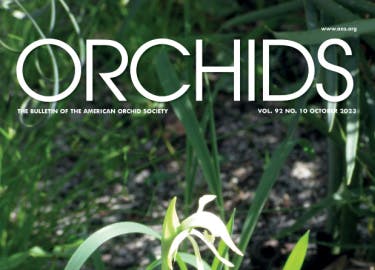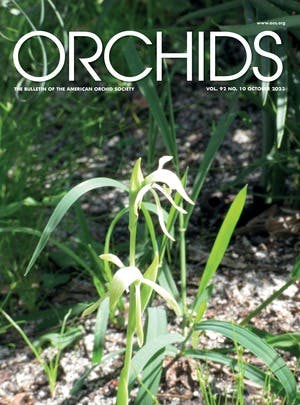
Your potential for exposure to inhaled aerosols and overspray is less when drenching, where gloves and boots can protect you from exposure. Products suitable for use as a drench are often described as being systemic or xylem mobile. By comparison, contact chemicals are effective only if they come into physical contact with the offender, so good coverage of all plant surfaces with the sprayed solution is essential. There are a few products that are described as being locally systemic, which means they can penetrate the leaf surface and move into the leaf so you can have less than perfect coverage of both upper and lower leaf surfaces and they are still effective.
If you have only a few plants, you can mix up a batch of systemic chemicals in a gallon (3.785 L) jug and just pour it through the pots, with just enough for the solution to begin to drain from the pots. This should allow the roots to be wet so they can absorb the chemical. A little fertilizer added to the drench will help with uptake. If you use a sprayer to water and fertilize your orchids, you can just direct the sprayer to the potting media surface to wet the roots. If you use Siphonex or Dosatron systems for fertilizing, you can add the chemical to your concentrate bucket. An aquarium aerator or frequent mixing of the concentrate bucket helps keep the chemicals in suspension.
SCALE AND MEALYBUGS
For scale and mealybugs, products containing imidacloprid (Merit, different Bayer Products) and dinotefuran (Safari) are both systemic products that are taken up by the root system and translocated upward throughout the plant. When applied as a foliar spray, they are translaminar, providing locally systemic control of foliar pests.
[1] If you grow cattleyas, scale is your nemesis. The combination of Safari and Distance can eliminate scale from your collection.

There are many products containing the active ingredient imidacloprid on the market, and these products are generally available at local nurseries and big box stores. The imidacloprid concentration varies widely among products, but the one labeled Tree and Shrub has 1.47% imidacloprid (even more concentrated specialty chemicals such as Merit are also available).
A great alternative to sprays and drenches is a granular chemical that can be spread around the top of the potting medium as a top dressing. When the plant is watered, the chemical is dissolved and carried down to the roots, absorbed, and transported up into the plant through the xylem. These granular chemicals tend to have a much lower concentration of active ingredients. You can simply wear gloves as you spread the chemical and be protected from ill effects. Another major benefit is the cost; the granular products tend to be much less expensive than their concentrated counterparts. There is a granular product often used by rose growers that contains 0.5% imidacloprid, sold as Criterion, Zenith, Grub-Away, Merit 0.5G, Hi-Yield Grub Free, Imidacloprid 0.5G and Generic Merit, among others. This can be very handy for a small infestation, where you just sprinkle some on top of the potting medium and water it in.
THRIPS
Systemic control of thrips using drenches is possible using products containing the active ingredients acephate (Orthene) and dinotefuran (Safari). Raymond Cloyd’s article, entitled “Control of Thrips with Systemic Insecticides” (Cloyd 2013), suggests that the more water-soluble systemics are more rapidly absorbed by the roots and translocated throughout the plant: “Here’s one example of how water solubility influences the uptake and efficacy of systemic insecticides. Imidacloprid (Marathon), which has a water solubility of 0.51 g/L or 500 ppm, tends to be less effective against flower- and pollen-feeding insect pests including Western Flower Thrips (WFT). Research has shown that acephate, which has a water solubility of 790 g/L or approximately 79,000 ppm, is converted into the metabolite methamidiphos and actually moves into flowers, protecting them from WFT feeding injury. It may provide systemic protection to flower buds, which allows plants to flower and minimizes feeding injury resulting in good flower quality.”
[2] Thrips feed on your flowers while they are still unopened buds. Periodic Orthene drenches can prevent floral damage and help control scale.

We have found Orthene drenches to be very effective at controlling floral damage to cattleya flowers. We apply it as a drench every two months, and no longer see thrips damage in the greenhouse. Safari should also work as a drench to protect flowers from thrips damage, although it is only about half as water soluble as Orthene.
Although thrips do not do much damage to waxy cattleya leaves, thrips often feed on the foliage of soft-leaved orchids such as catasetums. If leaf feeding is a concern in your growing area, as it is in many ornamental greenhouses, sprays rather than drenches may be more effective, as Cloyd (2013) states: “Spray applications of systemic insecticides tend to be more effective than soil/growing medium applications because they are being primarily used as contact or translaminar sprays, and not so much for any systemic activity.”
[3] Our hot humid summers create the conditions conducive for black rot to infect our cattleyas. Cultural controls together with specialty chemicals can help prevent black rot.

[4] Anthracnose is caused by leaf-spotting fungi. Remove the spores from your growing area and use protective chemicals to prevent the fungus from getting a foothold in your growing area.

MITICIDES
Kontos is the only systemic miticide for use as a drench, but the label does not recommend its use on orchids. For mites, look for locally systemic products with a translaminar activity that can be sprayed, such as Avid, which contains the active ingredient abamectin. In his article, “All Miticides are Not Created Equal” Cloyd (2004) states:
“Avid is a contact and translaminar miticide. Translaminar is a term that refers to insecticides/miticides that penetrate the leaf tissue and form a reservoir of active ingredient within the leaf. Avid generally provides up to 28 days of residual activity. The label rate for all mite species is 4 fl oz per 100 gal. Avid is active on the mobile life stages of mites, with no activity on eggs. Although the insecticide/ miticide is slow-acting, treated mites are immobilized after exposure.”
FUNGICIDES
Most of the affordable fungicides are contact chemicals, applied as sprays to leaf surfaces. Chlorothalonil (brand name Daconil) is effective for leaf spotting fungi, and botrytis and copper bearing chemicals (Kocide, Liquid Copper, and others) are effective bactericides. There are specialty fungicides available from nursing supply outlets that can be applied as drenches to protect against the water molds and bulb, root and stem rots, as well as sprayed to protect the aerial part of the plant. There are many different products on the market and many of them are quite expensive.
Some of these products are particularly effective on one type of disease. For example, Aliette and Subdue are often recommended for controlling black rot in cattleyas caused by water molds (pythium and phytophthora). If this is a persistent problem for you, you may want to invest several hundred dollars to use these products.
There are also broad-spectrum products such as Empress Intrinsic, Heritage SC, and Pageant Intrinsic containing strobins (FRAC group 11) that are labeled as effective for water molds, leaf, stem and root rots (such as rhizoctonia and fusarium) as well as leaf spotting fungi (such as cercosporoids and anthracnose) and can be used as both drenches and sprays. Although the strobins may not as effective as Aliette for black rot, they can be used to combat more than one disease, whereas Aliette is labeled only for treatment of water molds.
There are many simple-to-use granular fungicides on the market, mostly developed for turf grass on golf courses. These often contain the same active ingredients as are found in concentrated products such as Heritage, Banner Max II, Insignia, Pageant, Empress Intrinsic, Heritage, and others. Perhaps at some point, these products will be labeled for use on ornamentals. For now, there is one product labeled for use on ornamentals (though orchids are not specifically listed). Fame Granular fungicide contains 0.25% fluoxastrobin, and is reported to be effective for anthracnose, rhizoctonia, sclerotium, fusarium, phytophthora and pythium (as a preventative). Another granular product is 3336DGLite, which contains 2.08% thiophanate methyl, the same active ingredient as is found in Cleary’s 3336, Thiomyl, and Banrot. It is labeled for use in commercial horticultural applications. It is listed as effective for anthracnose and, when incorporated into the potting media as a preventative, for rhizoctonia and fusarium.
Before spending your hard-earned money on chemicals, make sure you do your research. First and foremost, you have to diagnose the problem you are trying to solve. Then identify which chemicals will provide thorough and lasting control. Systemic products that can be applied as drenches or top dressings should be high on your list. Read and understand the label instructions before buying or using any chemical.
REFERENCES
Cloyd, R. 2004. All Miticides are Not Created Equal. University of Illinois Extension Newsletter. https://hyg. ipm.illinois.edu/pastpest/200417g.html. Accessed August 17, 2023 _.
2013. Control of Thrips with Systemic Insecticides. Greenhouse Grower. https://www.greenhousegrower. com/production/insect-control/control-of-thrips-withsystemic-insecticides. Accessed August 17, 2023.
— Sue Bottom started growing orchids in Houston in the mid–1990s after her husband Terry built her first greenhouse. They settled into St. Augustine, Florida, Sue with her orchids and Terry with his camera and are active in the St. Augustine Orchid Society, maintaining the Society’s website and publishing its monthly newsletter. Sue is also a member of the AOS Editorial Board (email: sbottom15@gmail.com).






